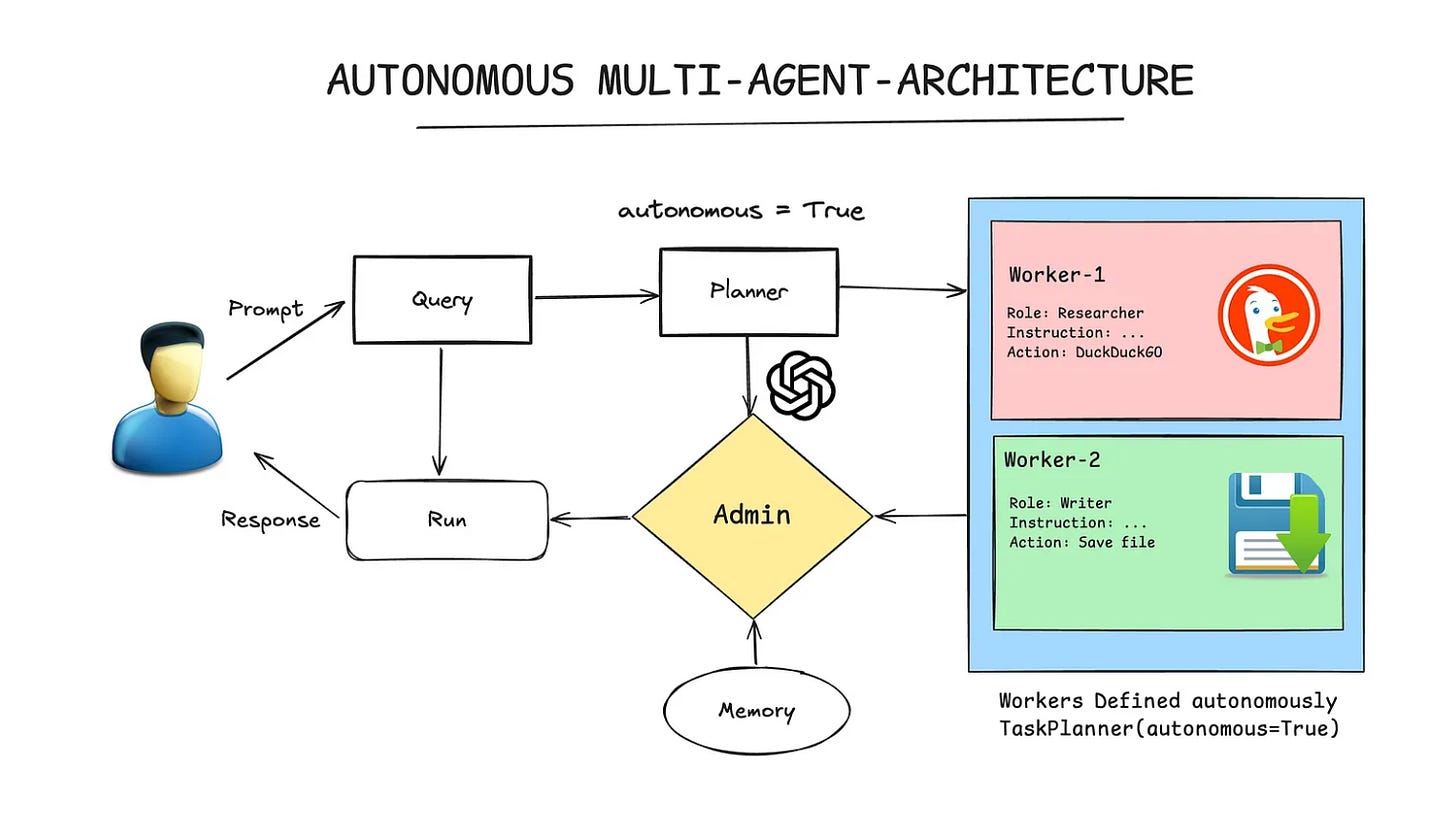A transformative approach is taking shape in the rapidly advancing field of AI, potentially reshaping our relationship with and advantages derived from intelligent systems. This article dives deep into the world of AI Agents, exploring their capabilities, potential applications, and the exciting future they herald for both individuals and industries.
What Are AI Agents?
AI Agents are artificial intelligence systems designed to perform complex, multi-step tasks autonomously, without the need for constant human intervention or predefined rules [1]. Unlike traditional AI models that respond to specific prompts or queries, AI Agents can understand broader goals, plan their actions, and execute tasks independently.
Key Characteristics of AI Agents:
Autonomy: They can operate and make decisions without continuous human guidance.
Goal-oriented: Agents work towards achieving specific objectives set by users.
Adaptability: They can adjust their strategies based on changing circumstances or new information.
Tool Use: Many AI Agents can leverage external tools and APIs to accomplish tasks.
State Representation: Agents maintain an internal representation of their environment and task progress.
For tech enthusiasts just starting to explore AI, you can think of AI Agents as advanced digital personal assistants. While current virtual assistants can perform simple tasks like setting reminders or playing music, AI Agents aim to handle much more complex and open-ended requests.
How Do AI Agents Work?
The functionality of AI Agents is built upon several key components and processes:
Perception: Agents gather information about their environment through various inputs, which could be text, images, or sensor data. This often involves natural language processing (NLP) techniques for text inputs or computer vision algorithms for image and video data.
Processing: The collected data is analysed using advanced AI models, typically large language models (LLMs) like GPT-4. These models use transformer architectures with attention mechanisms to process and understand complex inputs [5].
Planning: Based on their understanding of the task and environment, agents create a plan of action. This often involves techniques like:
Chain-of-Thought (CoT) Reasoning: This technique allows the agent to break down complex problems into smaller, manageable steps. It's implemented by prompting the LLM to "think through" the problem step-by-step [2].
Tree-of-Thoughts (ToT): An extension of CoT, ToT allows the agent to explore multiple reasoning paths simultaneously, creating a tree-like structure of potential solutions [3].
Execution: Agents carry out their plan, which may involve:
Tool Use: Techniques like Tool former [6] enable agents to learn when and how to make API calls to external tools.
Action Generation: The agent may generate text, code, or other outputs based on its plan.
Learning and Adaptation: Agents can learn from their experiences and adjust their strategies for future tasks. This often involves reinforcement learning techniques or fine-tuning of the underlying language models.
Technical Deep Dive: Multi-Agent Architectures
One of the most promising developments in AI Agent technology is the concept of multi-agent systems. Various frameworks enable multiple specialised agents to collaborate on complex tasks. This approach offers several advantages:
Specialisation: Each agent can focus on a specific subtask or role, leading to better performance.
Modularity: The system can be more easily updated or modified by adjusting individual agents.
Scalability: Multi-agent systems can potentially handle more complex tasks by distributing the workload.
Emergent Behaviour: The interaction between agents can lead to novel problem-solving approaches.
Implementing a multi-agent system involves several key technical challenges:
Agent Communication: Developing protocols for efficient and effective information exchange between agents.
Task Decomposition: Automatically breaking down complex tasks into subtasks that can be distributed among agents.
Conflict Resolution: Managing situations where different agents may have conflicting goals or strategies.
Resource Management: Efficiently allocating computational resources among multiple agents.
Applications of AI Agents
The potential applications for AI Agents are vast and span numerous industries. Here are some key areas where AI Agents are making an impact:
1. Customer Support
AI Agents are revolutionising customer service by autonomously handling a wide range of customer queries and actions. These systems can manage thousands of conversations simultaneously, effectively scaling customer support operations.
From a technical perspective, these customer support agents often combine:
Natural Language Processing (NLP) for understanding customer queries
Knowledge retrieval systems to access relevant information
Task-oriented dialogue systems for managing conversation flow
2. Software Development
AI Agents are being developed that can autonomously write, test, and deploy code. These agents aim to automate significant portions of the software development lifecycle, potentially transforming how software is created.
Key technical components include:
Code generation models fine-tuned on large codebases
Static analysis tools for error checking
Automated testing frameworks
Version control integration
3. Data Science and Analytics
AI Agents are emerging that can automate various aspects of the data science workflow, from problem framing and data selection to model training and deployment.
These agents often leverage:
Automated feature engineering techniques
AutoML (Automated Machine Learning) for model selection and hyper-parameter tuning
Data visualisation libraries for generating insights
4. Regulatory Compliance
AI Agents are being developed to assist with complex regulatory compliance tasks. These agents can review operations, identify compliance issues with specific regulations, and suggest remedial actions.
Technical challenges in this domain include:
Natural Language Processing for understanding complex legal texts
Knowledge graph construction to represent regulatory relationships
Logical reasoning systems for applying rules to specific scenarios
5. Personal Assistance
Perhaps one of the most exciting applications for individual users is the development of AI personal assistants. These systems can manage calendars, coordinate tasks, and even help plan complex activities like vacations.
These systems often integrate:
Natural Language Understanding (NLU) for processing user requests
Task planning algorithms for breaking down complex requests into actionable steps
API integration with various services (e.g., calendar apps, travel booking sites)
Personalisation models to learn and adapt to user preferences over time
Challenges and Considerations
While the potential of AI Agents is immense, there are several challenges and considerations to keep in mind:
Reliability: Ensuring consistent and accurate performance across a wide range of tasks and scenarios remains a significant challenge. This often requires robust error handling, fallback mechanisms, and extensive testing across diverse scenarios.
Security and Privacy: As AI Agents handle more sensitive tasks and data, ensuring robust security measures and protecting user privacy becomes crucial. This involves implementing strong encryption, secure API handling, and adherence to data protection regulations.
Ethical Considerations: The autonomous nature of AI Agents raises important ethical questions about decision-making, accountability, and potential biases. Techniques like algorithmic fairness and interpretable AI are being explored to address these concerns.
Integration with Existing Systems: For widespread adoption, AI Agents need to seamlessly integrate with current software ecosystems and workflows. This often requires developing standardised APIs and protocols for agent communication and action.
Scalability and Efficiency: As AI Agents become more complex, managing computational resources and ensuring efficient operation at scale becomes a significant challenge. Techniques like model compression, distributed computing, and efficient attention mechanisms are active areas of research.
The Future of AI Agents
The field of AI Agents is rapidly evolving, with new advancements and applications emerging regularly. Some exciting areas to watch include:
Improved Reasoning Capabilities: Ongoing research aims to enhance agents' ability to reason, plan, and solve problems more effectively. This includes work on causal reasoning, common sense reasoning, and more advanced planning algorithms.
Multi-Modal Agents: Future agents will likely be able to process and generate multiple types of data (text, images, audio, video) seamlessly, enabling more natural and versatile interactions.
Continual Learning: Developing agents that can learn and adapt on-the-fly, without the need for explicit retraining, is an active area of research.
Explainable AI Agents: As agents become more complex, there's a growing need for techniques that can explain their decision-making processes in human-understandable terms.
Conclusion
AI Agents represent a significant leap forward in artificial intelligence, moving us closer to systems that can truly understand, plan, and act in ways that meaningfully augment human capabilities. While there are certainly challenges to overcome, the potential benefits in terms of productivity, efficiency, and new capabilities are immense.
For both tech enthusiasts and professionals, staying informed about the development of AI Agents will be crucial in the coming years. Whether you're a developer looking to integrate these technologies into your projects, a business leader considering how AI Agents could transform your operations, or simply someone fascinated by the cutting edge of technology, the world of AI Agents offers a glimpse into an exciting future where the line between human and artificial intelligence continues to blur.
References
[1] Glover, E. (2024). What Are AI Agents? Built In.
[2] Wei, J., et al. (2022). Chain-of-Thought Prompting Elicits Reasoning in Large Language Models. arXiv:2201.11903.
[3] Yao, S., et al. (2023). Tree of Thoughts: Deliberate Problem Solving with Large Language Models. arXiv:2305.10601.
[4] Toews, R. (2024). Agents Are The Future Of AI. Where Are The Startup Opportunities? Forbes.
[5] Han, S., et al. (2024). LLM Multi-Agent Systems: Challenges and Open Problems. arXiv:2402.03578.
[6] Schick, T., et al. (2023). Toolformer: Language Models Can Teach Themselves to Use Tools. arXiv:2302.04761.













Share this post